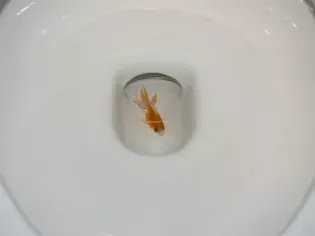Do Not Flush That Fish
Updated on 04/26/24

Do Not Flush That Fish: The Perils of Improper Pet Disposal
Introduction
The allure of keeping exotic pets can be irresistible, but their disposal, when the time comes, often poses a significant challenge. Flushing fish down the toilet may seem like a convenient solution, but it's a profound mistake with far-reaching consequences. This article will delve into the perils of improper pet disposal, emphasizing the ecological, sanitary, and legal implications.
Ecological Impact
Invasive Species:
Flushing non-native fish into waterways introduces invasive species that disrupt the delicate balance of aquatic ecosystems. These fish may outcompete native species for food and habitat, leading to population declines. For example, the introduction of lionfish in the Atlantic Ocean has decimated native reef fish, disrupting the entire food chain and damaging coral reefs.
Disease Transmission:
Diseased fish can transmit pathogens to native populations, leading to widespread epidemics. These diseases can spread through the water column, affecting fish and other aquatic organisms. For example, the introduction of koi herpesvirus in the United States has caused significant mortality among native carp populations.
Blockages and Infrastructure Damage:
Flushed fish can contribute to blockages in sewage systems and wastewater treatment facilities. Fish bodies and waste can clog pumps, pipes, and screens, causing operational disruptions and costly repairs.
Sanitary Concerns
Water Contamination:
Flushing fish introduces organic matter into waterways, which can increase bacteria levels and cause water contamination. This can pose health risks to humans and aquatic life, especially during periods of heavy rainfall or flooding.
Odor and Aesthetic Issues:
Decomposing fish can create unpleasant odors and attract pests, making waterways and surrounding areas less desirable for recreation and aesthetic enjoyment.
Legal Implications
Environmental Regulations:
Many countries and municipalities have laws prohibiting the release of non-native species into the environment. Flushing fish down the toilet violates these regulations and can result in fines or legal action.
Property Damage:
Flushing fish can damage plumbing systems and cause property damage to both residential and commercial buildings. Property owners may be held liable for the costs of repairs.
Proper Pet Disposal Alternatives
Recognizing the potential hazards of improper pet disposal, it is crucial to explore responsible alternatives.
Surrender to Pet Stores or Rescues:
Many pet stores and animal rescues will accept unwanted fish. They have the expertise and resources to humanely care for and rehome the animals.
Euthanasia and Burial or Cremation:
For fish that cannot be rehomed, humane euthanasia followed by burial or cremation is the most recommended option. Licensed veterinarians can perform euthanasia, and pet crematories provide respectful and dignified disposal services.
Composting:
Small fish can be composted in a backyard compost pile, provided they are mixed with other organic matter such as leaves or grass clippings. Composting fish provides nutrients for plants without harming the environment.
Conclusion
Flushing fish down the toilet is an irresponsible practice with potentially devastating consequences. It threatens ecosystems, poses sanitary concerns, violates laws, and damages property. By understanding the risks and exploring responsible alternatives, pet owners can ensure the welfare of their animals and protect the environment for future generations.
Explore More Pets

Freshwater Aquarium Filters
How to Deal With Cloudy Aquarium Water

Saltwater Aquarium Filters
How Do You Remove Chloramines From Tap Water?

Freshwater Aquariums & Habitat
Can I Keep My Koi Fish Inside?

Saltwater Aquariums & Habitat
14 Best Floating Plants for Your Aquarium

Freshwater Fish Health
How to Treat Ich on Freshwater Fish

Saltwater Fish Health
Fin Rot in Aquarium Fish

Freshwater Aquarium Filters
How to Do Aquarium Water Changes

Saltwater Fish Health
How Do Fish Get Parasites?